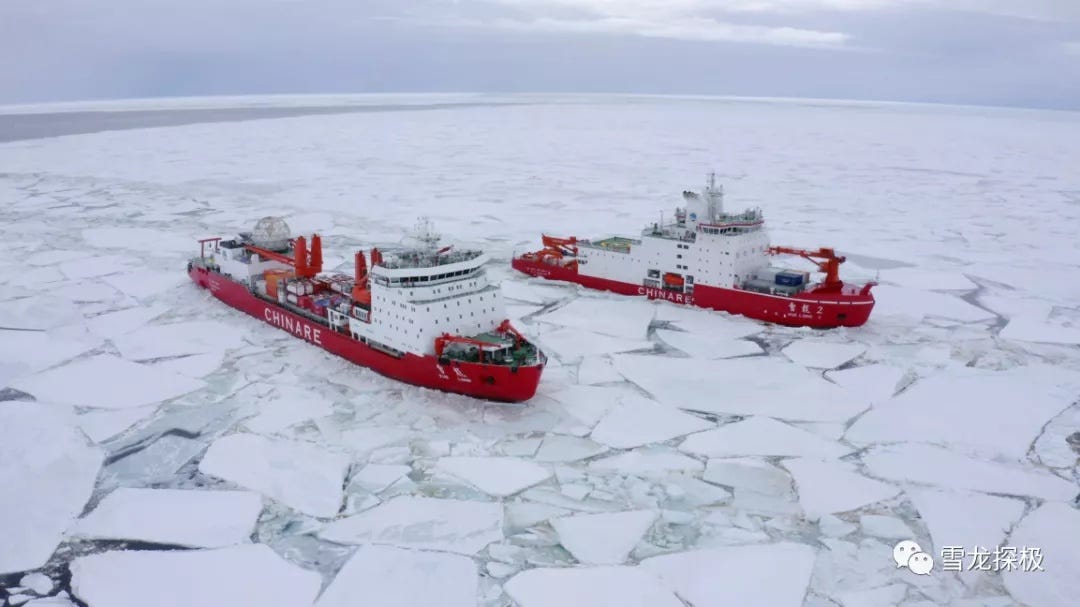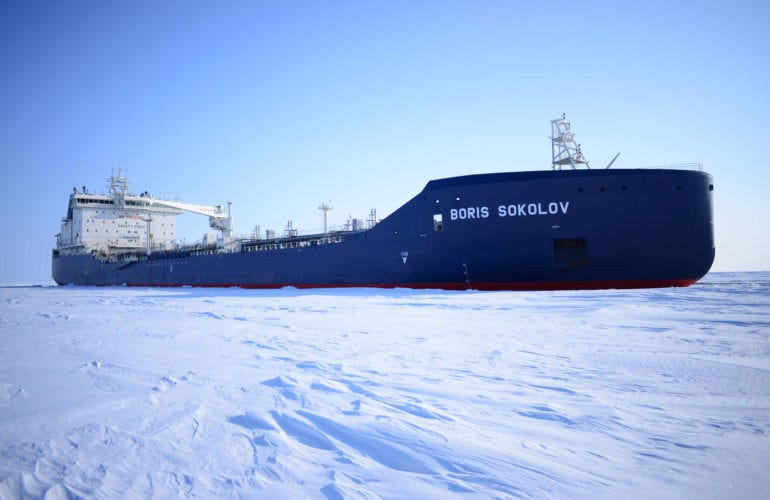An Overview of China's Polar Fleet
China's growing capability to domestically produce ice-capable ships is concerning enough. There's no need to exaggerate the capabilities of their current polar fleet.
Note: This article originally included far more detail about China’s polar vessels. In the interest of length and focus, I am saving a deep dive into each vessel’s capability for future installments. I will likely begin a series next that will take a deep dive into a single vessel or vessel class in each installment, beginning with China’s vessels. Let me know what you think of this “vessel of the week” idea.

A quick note on terminology:
Ships “constructed of steel and intended for independent navigation in ice-infested polar waters” contracted after July 1, 2007, must meet the rules of the Uniform Requirements for Polar Class Ships. These rules standardized the notation awarded by classification societies such as the American Bureau of Shipping, Lloyd’s Register, and the Chinese Classification Society, enabling a comparison of polar class ships. For comparison's sake, older vessels are often discussed as having a ‘Polar Class equivalent.’
Classification societies also have an additional notation for “icebreaker.” Polar Class vessels wishing to receive icebreaker notation often require additional hull strength, machinery redundancy, or equipment installation beyond the requirements of Polar Class alone1. Not every Polar Class vessel is, therefore, an icebreaker. Somewhat complicating this, there is no international standard for icebreaker notation. Each classification society has their own.
China’s Polar Research “Icebreakers”
Technically speaking, none of China’s polar vessels have an icebreaker notation, which is why I use quotes around “icebreaker” in this context.
Here is a summary chart depicting some of the capabilities of China’s polar capable vessels:
Note that all of these ships are operated as research vessels and owned by scientific research institutions. In addition to performing research, Xue Long and Xue Long 2 are designed to carry and deliver supplies to China’s Antarctic research stations. As China’s five current Antarctic stations are located further North than the U.S. Antarctic Program’s McMurdo Station, their ice class is sufficient to reach these locations. A more capable vessel such as the U.S. Coast Guard’s Polar Star is required to support the re-supply of McMurdo Station.
I placed this chart at the beginning for easy reference. For comparison, here a chart depicting the size and Polar Class of some select polar vessels2:
You can read more about Le Commandant Charcot here, and Nordica and Fennica here.
Polar Class Commercial Vessels for Export
Guangzhou Shipbuilding International has also built four large polar class commercial vessels for foreign clients: two PC3 module carriers, Audax (2016) and Pugnax (2016), and two PC3/Arc7 tankers, Boris Sokolov (2018) and Anatoly Lamekhov (2024). The module carriers were designed to carry 20,000-ton modules to sites along the Northern Sea Route. The Boris Sokolov and Anatoly Lamekhov are both 214m long and 34m at the beam. Sokolov, an oil/condensate tanker, can carry nearly 50,000 tons of oil while Anatoly Lamekhov, a chemical/oil products tanker, has a cargo capacity of 64,000 tons. Note that Audax, Pugnax, and Boris Sokolov were designed by Aker Arctic of Finland (like Xue Long 2) while Anatoly Lamekhov is derived from an earlier Aker Arctic design.
Planned Heavy Icebreaker

In addition, China is planning on building a research-oriented heavy icebreaker, possibly nuclear powered. There are many rumors and lots of speculation about this vessel, but as of yet there is no confirmation that it is under construction or what it will look like.
In 2019, China’s Shipbuilding Industrial Corporation unveiled a model of a proposed heavy icebreaker at the International Maritime Conference and Exhibition in Shanghai. The planned heavy icebreaker may be based on this design; at this stage, we simply don’t know.
We should learn more in the coming months, as construction is scheduled to begin this year. From an August 2024 article in Global Times:
The research and development of China's heavy icebreaker is progressing smoothly with construction expected to begin next year, Wu Gang, chief designer of Xue Long 2, China's first domestically built polar research icebreaker, told the Global Times.
He also implies that this heavy icebreaker will use mainly Chinese built components:
He highlighted the challenges in advancing crucial technologies for the development of heavy-duty icebreakers, like podded propulsion systems, precise communication navigation system and positioning system. "This pressure pushes Chinese researchers to continue to develop and innovate independently," he said.
Possible Cooperation with Russia
In the past, Russia has resisted cooperating with China in building icebreakers. In a 2023 article, The Diplomat reported that:
Russia’s Ministry of Industry and Trade disqualified Chinese shipyards in 2021 from bidding on a contract to build two conventionally powered icebreakers: “Transferring design documentation for icebreakers to China is unacceptable, as it would place Russia in competition with a partner in Arctic development,” a ministry spokesperson explained.
However, much has changed since 2021. Cooperation between China and Russian has increased while Western sanctions limit Russian access to components and technology, leading to delays in ship construction.
In August 2024, China and Russia released a joint communique pledging deeper cooperation in, among other things, cooperation in building icebreakers. As reported in Global Times:
In the communique, the two sides said that efforts will be made to expand mutually beneficial cooperation in the Arctic region, and strengthen cooperation in shipping development, navigation safety, polar ship technology and construction. Both countries will encourage their enterprises to actively engage in Arctic shipping routes cooperation based on market principles and pay special attention to Arctic environmental conservation.
Thoughts and Comments
Popular press reports often reference China’s growing fleet of polar “icebreakers” or state the size of China’s polar fleet without adding context on its capabilities.
The reality is that China’s most capable vessel- Xue Long 2- was designed by Aker Arctic of Finland and produced with foreign sourced components. Xue Long 2 is a polar research vessel, roughly equal in capability to the U.S. Coast Guard’s Healy. While Xue Long 2 is more than capable of supporting China’s Antarctic stations and conducting planned Arctic research voyages during some parts of the year, it is not capable of escorting ships through the sea ice found in places along the Northern Sea Route.
This does not mean that we should ignore China’s polar programs. On the contrary, we must pay attention to China’s growing ability to build such vessels.
Crawl, Walk, Run
According to He Guiangwei, deputy chief engineer of China State Shipbuilding International:
China has gone through two stages of development in recent decades: the commissioning and modification of entire ships purchased abroad, and the introduction of joint foreign design and foreign equipment.
Xue Long, purchased from Ukraine and modified in China, is a good example of stage one. Xue Long 2 belongs to the second stage, as it was designed by Aker Arctic of Finland but built in China by Jiangnan Shipyard.
He then describes the design and construction of Tan Suo San Hao as part of a third phase:
"Now, for domestic scientific research vessels, we are entering a new phase of independent construction," He Guangwei said, adding, "that this scientific research vessel is the first independently developed and built Chinese high-ice class research vessel in the polar regions."
“The Polar class vessels represent a growing area of expertise for GSI, and we are delighted to work with a reliable partner whose reference list of proven technology in this demanding segment is second to none."
In U.S. military training, we often refer to this as the crawl, walk, run approach. And it seems to be working for China. First, they modified an existing ice capable vessel. Then they built one with foreign assistance, and then two more of their own design using materials increasingly sourced from China. For example, the Azipods used on these two Chinese-design vessels were manufactured at ABB’s plant in Shanghai3.
Notably, all of the polar ships were built by the government owned China State Shipbuilding Company (CSSC), with seven of eight4 built by Guangzhou Shipbuilding International (GSI). The most recently completed vessel, Tan Suo San Hao, took only eighteen months. The eighth (Xue Long 2) was built by Jiangnan Shipyard, which also built the Chinese aircraft carrier Fujian and a host of other ships for the PLAN.
With this crawl-walk-run approach to designing and building polar vessels, China’s capability to build ships at scale, increasing domestic production of major components5, and potential cooperation with Russia, China could soon have the ability to rapidly build large quantities of more capable polar class vessels- including warships.
I did not include the small number of ice-capable patrol vessels operated by the Chinese Coast Guard and the Peoples’ Liberation Army Navy (PLAN) that operate mainly in the Bohai Sea. Perhaps another time.
That’s it for today. There is a lot more to write about China’s polar programs and ambitions. Right now, I’m working on a deeper dive into each of China’s polar vessels. Let me know what you think of using them as a way to start a shorter “vessel of the week” article in addition to longer analyses like this one.
All the Best,
PGR
Polar Star’s high propulsion power comes from three gas turbine engines. Note that because of technological change, modern ships can break equivalent ice with less propulsion power.
According to a press release, ABB Shanghai plant builds Azipod propulsors of 7.5 megawatts or less. This includes the simple water-cooled version as well as the more complex hybrid cooled models that also include cooling air units. The more complicated units- like the 17 MW Azipods fitted to Le Commandant Charcot- are built in Finland.
The eighth (Xue Long 2) was built by Jiangnan Shipyard, which also built the Chinese aircraft carrier Fujian and a host of other ships for the PLAN.
In addition to ABB, many foreign firms operate manufacturing subsidiaries in China. Although the intellectual property belongs to the foreign parent firm, China’s history of IP theft indicates that over time, it becomes more likely that Chinese firms will be able to produce these components wholly domestically.








Having separate posts on individual ship designs is a welcome idea.
Why it is concerning, that China can build ice capable ship domestic? China, as well as many countries share scientific interest on Polar areas. There is probably only one country in the world who wants to militarize Arctic.